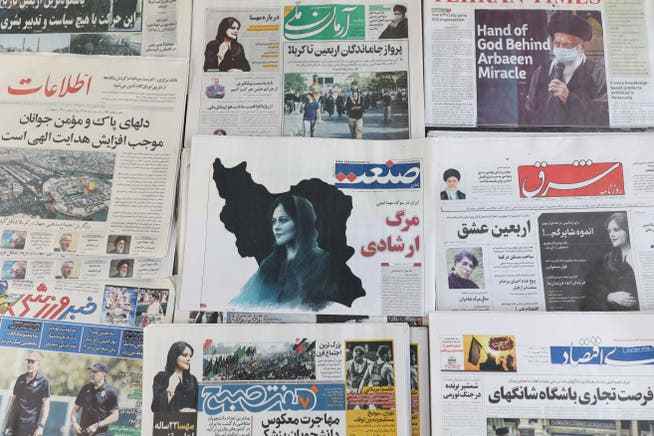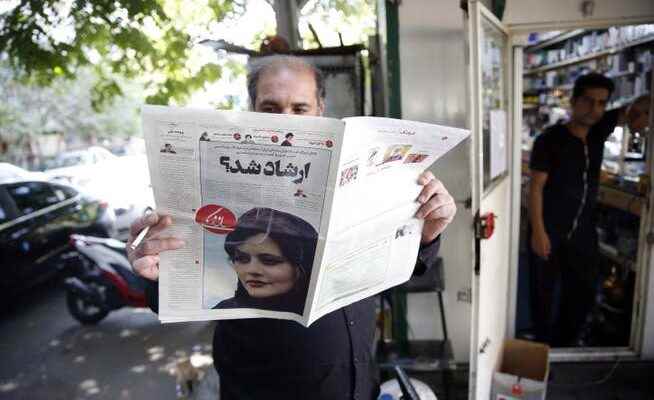Forty media representatives have been arrested since the beginning of the protests against compulsory headscarves in Iran. It affects well-known moderators in Tehran as well as unknown bloggers in the province. This has direct consequences for reporting on the protests.
“Was it the morality police?” the newspaper “Kargaran-e sazandegi” asked on September 18 after Mahsa Amini’s death. The press no longer dares to ask such questions.
It was early morning when Secret Service agents entered the home of Nilufar Hamadi invaded Tehran. They searched the journalist’s home, took her laptop and took her away. Hamadi was only able to telephone her husband four days after her arrest on September 22nd. She is in solitary confinement in Evin prison and is regularly interrogated, she said. To date, she has not learned the reason for her detention. But it can be assumed that the reporter of the reform-oriented daily «Sharq» was arrested for reporting on the death of Mahsa Amini.
Hamadi was one of the first to report the case of the young Kurdish woman, who fell into a coma after being arrested by morality police in Tehran on September 13. She visited the 22-year-old in Tehran’s Kasri Hospital and published a photo of Amini’s parents hugging in desperation in the hallway. According to the authorities, Amini died three days later as a result of a previous illness of a heart attack. However, her family believes that she was severely abused by the morality police.
Hamadi is just one of dozens of journalists who have been detained in Iran since the protests began. Some have been like the photographer Yalda Moyeri arrested at demonstrations, others at the editorial office or in their homes, like Hamadi. That Committee to Protect Journalists currently counts forty media professionals who have been imprisoned since mid-September.
Preventive Arrests
Some have been targeted by the regime for their articles or tweets, while others have apparently been pre-emptively detained to prevent them from writing about the protests. Among them are media veterans like that 60-year-old television presenter Mahmud Shahriari and columnist Majid Tavakoli, previously imprisoned during the 2009 Green Movement. others are little-known bloggers, freelance journalists in remote provincial towns. It is striking how many women are among those arrested.

After Mahsa Amini’s death on September 16, a number of newspapers such as “Sanaat” and “Sharq” (middle) reported on the case. But the arrest of dozens of journalists has silenced critics.
Only a few newspapers, such as “Sharq”, still report in detail on the protests. Others are completely silent or take the official line that it is a foreign conspiracy. The hard-liner newspaper Keyhan blamed IS supporters for the unrest and accused Saudi Arabia of being the mastermind. The Fars news agency claimed that Mahsa Amini was just a pretext for the protests and called for a crackdown.
The newspaper “Hamshahri”, which belongs to the Tehran city government, denounced the end of September on their front soccer star Ali Karimi and other celebrities who had shown solidarity with the demonstrators. In addition to critical journalists, the regime has also arrested filmmakers, singers and actresses as well as athletes, lawyers and academics in recent weeks for their support of the protests.
Brutal abuse
In the case of blogger and activist Hossein Ronaghi the agents came while he was doing a live television interview in Tehran. He managed to escape at the last moment, but turned himself in to the police two days later. When he appeared in court with two lawyers, he was beaten and arrested. His lawyers were arrested at the same time. A few days later he reported to his mother from prison that his leg had been broken.
The procedure was just as brutal in the arrest of literary critic Farshid Gorbanpur. The editor of the booklet of the Haft-e Sobh newspaper, his wife and their four-year-old son were jolted from their sleep at 3am when officers burst into the home, shot in the air and beat up Gorbanpur in front of his child. They used so much pepper spray that they gasped for air themselves. Since then, Gorbanpur has been sitting in Evin without charge.
178th out of 180 for freedom of the press
Iran has been at the bottom of the press freedom rankings for years. It is currently ranked by Reporters Without Borders Ranked 178th out of 18o. The times at the end of the 1990s when there was a lively debate in the press about the relationship between politics and religion and about reforming the system are long gone. A large number of newspapers are still available at the kiosks, but there is hardly any critical journalism to be found in them.
The newspapers are subject to strict state censorship, and violations can result in high penalties. Many newspapers and news agencies are themselves state-owned or controlled by regime institutions. Television and radio are in any case directly subordinate to the revolutionary leader. All media that do not stick to the red lines face a ban. Since it is often unclear what is permitted, most journalists practice self-censorship.
Since state television is discredited in the eyes of many Iranians, they obtain their information from exile broadcasters such as Manoto. The BBC, Voice of America, Deutsche Welle and Radio France International also have programs in Persian. Another source is the Saudi-funded exile broadcaster Iran International. In addition, there are a variety of channels that bring soap operas and other entertainment. For years the regime has been trying to enforce its ban on satellite dishes. But at least it lost this fight.
